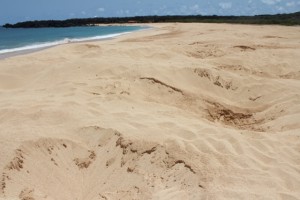



We have arrived! Our Royal Air Force flight arrived on Ascension Island around 8 this morning and we didn’t waste any time getting started! We were met at the airport by Drs Brendan Godley and Annette Broderick, two sea turtle biologists from the University of Exeter (U.K.) who have been conducting research on the island for 15 years, and we were off to check into the hotel. Before we knew it we were heading to the Ascension Island Conservation Office to meet with Drs. Sam Weber and Nicola Weber, the two conservation officers on the island. They gave a short presentation on the flora and fauna of the island and told us about some of the things that we would be doing with them while we’re here, beginning with checking out endemic (only found in one area of the world) land crab spawning this evening around dusk and going to Long Beach, the most dense nesting beach on the island, to see nesting sea turtles tonight.
Next we took a quick drive up the “mountain” adjacent to Long Beach and to see an aerial view of where we would be spending many of our nights over the next week. When we headed down to the beach the number of turtle nests was completely overwhelming! In coastal North Carolina we get a few nests here and there on the beaches but here you can barely walk without falling into a pit dug by nesting females this season! I can’t believe that we will be spending our nights out here watching the turtles dig their pits and lay eggs.
After some down-time in the afternoon we met with the conservation officers to head to Northeast Beach, where the island’s endemic land crabs would be spawning around dusk. This spawning event only happens for ~3 days at a time and only for a few months out of the year, so it is really lucky that it coincided with our time here! The crabs live on Green Mountain, the highest point on the island and some of the only green on Ascension, and migrate down the mountain and to this specific beach for their spawning events, mating on the way. At the peak (the night before we arrived), there can be 15,000 crabs spawning on the beach in one night and each female can have thousands of eggs! During the day the crabs hide in the shadows of rock outcroppings in order to stay cool and they start moving a little as the sun goes down. Shortly after dark the crabs make their way to the water, just to where the waves come in, and do a “dance” to drop their eggs in the water as the water is receding after a wave. The eggs have been incubated while in the females and hatch almost instantly when hitting the water. As soon as the eggs are dropped another type of crab emerges, the mole crab. These crabs are about the size of the top joint of a human finger and are generally burrowed under the sand in the wave zone but emerge to feed on the eggs/larvae of the land crabs. After the crabs have spawned they will head back up to their home on Green Mountain.
After a late dinner we headed back to Long Beach to see turtle nesting in action. This was the first time that any of the students in the class had seen a nesting sea turtle and it certainly was a sight! We were assisted in our search by two of the conservation interns, Daniel and Emily, who found a turtle at the right stage on the beach for us to witness and explained both what was happening with the turtle as well as some of the things that they do, such as taking measurements of the turtles carapace and inserting a temperature logger into the nest. We didn’t spend much time on the beach tonight since we are all still exhausted from the trip here, but in the coming days we will be doing the measurements and collecting data ourselves!
It was a long, exciting, action filled day and a great intro to the types of experiences that we will have over the next 8 days on the island!
